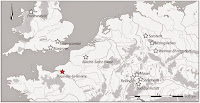Modern DNA recovery techniques have allowed scientists to recover genetic sequences from a number of Neanderthal individuals (members of a fairly well known Archaic Human population found in Europe and West Asia before about 40 000 years ago) as well as some Denisovans (members of a poorly understood Archaic Human population found in Central Asia before about 50 000 years ago). This has led to the discovery of genetic material derived from these ancient populations within many modern Human groups, and, more recently, attempts to determine what genes preserved from Archaic Human groups might contribute to modern Humans. Such studies have found evidence of Neanderthal DNA in all non-African modern populations, while Denisovan DNA has been found only in Melanesian populations.
In a paper published in the journal Science on 17 March 2016, a team of scientists led by Benjamin Vernot of the Department of Genome Sciences at the University of Washington present the results of a study of the genomes of 1523 modern Humans from around the globe, including 35 Melanesians from Papua New Guinea and the Bismarck Archipelago, and attempt to analyse the preserved DNA sequences in these individuals.
Melanesian genomic variation in a global context. (A) Locations of the 159 geographically diverse populations studied. Information on the Melanesian individuals sequenced (blue triangles) is shown in the inset. Vernot et al. (2016).
All Humans, including Archaic populations such as Neanderthals and Denisovans, share almost all of their DNA. In this context 'Neanderthal DNA' or 'Devisovan DNA' refers to variable alleles found in the ancient population, but not in modern African populations not thought to share any genetic heritage since the ancestors of these groups left Africa in the Middle Pleistocene. An allele is one of two or more different genes that can occur at a
gene locus, for example different alleles for blue or brown eyes may be found at
the gene locus for eye colour in Humans
The highest proportion of Neanderthal DNA was found in modern East Asians, with Europeans having a slightly lower level and South Asians a slightly lower level still. The proportion of Neanderthal found in Melanesians was much lower (roughly half) than that found in any of these groups, but still much larger than the highest found in any African group (people from the Western Division of The Gambia).
Only Melanesians were found to have significant levels of Denisovan DNA (trace amounts were found in samples from East and South Asians), who had slightly higher levels of Denisovan DNA than they did Neanderthal DNA - though the combined level of Denisovan and Neanderthal DNA found in Melanesians was slightly higher than that found in East Asians.
The areas of DNA from Archaic populations were not random, but rather similar sections of Archaic DNA appear to have been retained in different populations. This suggests that some Archaic DNA alleles were strongly selected against in the ancestors of modern humans, while others appear to have been more useful. In particular Vernot et al. note that a section of Archaic DNA alleles in an area of chromosome 7 associated with language skills has been lost in all modern Humans. Conversely a number of Archaic alleles associated with the metabolism have been retained in different modern Human populations, including genes associated with glucose metabolism and lipid processing. A number of genes associated with the immune system have also been conserved.
See also...
 Genetic data from two new Denisovan individuals. The Denisonvans were an ancient
people who are known from only a single archaeological site, a cave...
Genetic data from two new Denisovan individuals. The Denisonvans were an ancient
people who are known from only a single archaeological site, a cave...
 Neanderthal DNA from a 37 000-42 000 modern Human jaw from Romania. Neanderthals first appeared in
Europe around 300 000 years ago and were replaced by anatomically modern Humans
between 45 000 and 35 000 years ago. Genetic studies if modern Human
populations show that almost all non-Africans have traces of Neanderthal...
Neanderthal DNA from a 37 000-42 000 modern Human jaw from Romania. Neanderthals first appeared in
Europe around 300 000 years ago and were replaced by anatomically modern Humans
between 45 000 and 35 000 years ago. Genetic studies if modern Human
populations show that almost all non-Africans have traces of Neanderthal...
 Human remains from the Middle Pleistocene of Normandy. Early and Middle Pleistocene Human remains are extremely rare in
northern Europe, having to date...
Human remains from the Middle Pleistocene of Normandy. Early and Middle Pleistocene Human remains are extremely rare in
northern Europe, having to date...
See also...
 Genetic data from two new Denisovan individuals. The Denisonvans were an ancient
people who are known from only a single archaeological site, a cave...
Genetic data from two new Denisovan individuals. The Denisonvans were an ancient
people who are known from only a single archaeological site, a cave... Neanderthal DNA from a 37 000-42 000 modern Human jaw from Romania. Neanderthals first appeared in
Europe around 300 000 years ago and were replaced by anatomically modern Humans
between 45 000 and 35 000 years ago. Genetic studies if modern Human
populations show that almost all non-Africans have traces of Neanderthal...
Neanderthal DNA from a 37 000-42 000 modern Human jaw from Romania. Neanderthals first appeared in
Europe around 300 000 years ago and were replaced by anatomically modern Humans
between 45 000 and 35 000 years ago. Genetic studies if modern Human
populations show that almost all non-Africans have traces of Neanderthal... Human remains from the Middle Pleistocene of Normandy. Early and Middle Pleistocene Human remains are extremely rare in
northern Europe, having to date...
Human remains from the Middle Pleistocene of Normandy. Early and Middle Pleistocene Human remains are extremely rare in
northern Europe, having to date...
Follow Sciency Thoughts on
Facebook.

